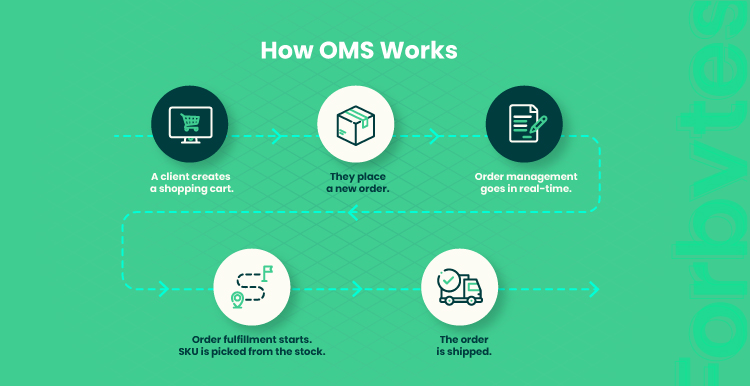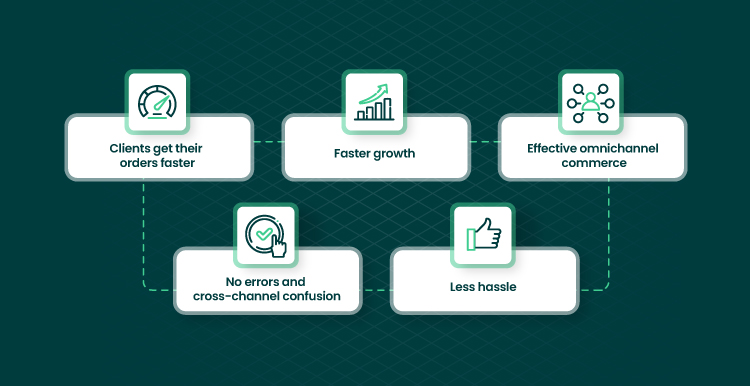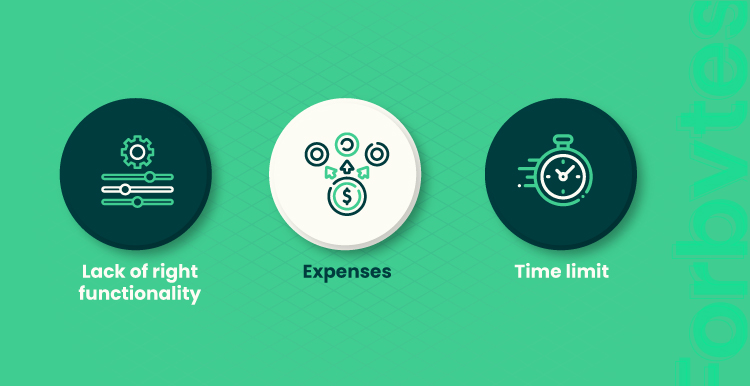Order management is a vital part of any business that involves tracking sales, orders, inventory, and fulfillment. But it can come with challenges, especially in e-commerce, where the number of orders grows with the emergence of new customers and business expansion.
Companies often face issues that restrain their performance. They may suffer from poor communication between departments, and manual processing errors like incorrect data entry or misplaced orders further delay order fulfillment and frustrate customers. These conditions can harm your business.
Order management systems (OMS) solve these problems by automating and streamlining the entire order process, from placement to delivery. What’s more, order management systems enhance operational efficiency, boost customer satisfaction, and drive business growth.
But not all online stores know why they should implement order management systems and how they will benefit from these automated platforms.
Luckily, you’ve come to the right place. In this post, the Forbytes team will guide you through the functions of OMS and its value for your business. Hopefully, this information will lead you in the right direction.
What Is E-Commerce Order Management?
E-commerce order management involves all processes of managing an order. From placing an order by a client to shipping products to the destination — all these processes can be unified under the term e-commerce order management.
Some time ago, retailers did order management manually. They used spreadsheets or tables and updated them with new data for others to keep pace with order progress. Now, this practice is too inefficient to be used by progressive e-commerce businesses.
The goal of e-commerce order management is to facilitate order processing and fulfillment. It automates the work of many departments, reduces the risk of errors, and saves a ton of time. How can businesses achieve this? Surely, with e-commerce order management software.
More and more retailers are trying different e-commerce integration strategies. They add order management solutions into their work to stay adaptable to changing client needs and respond to them effectively. The need for this operational software may not be that obvious when business is only at the start. But when an e-commerce website scales up and the number of orders and items in the PIM grows, enterprises look for an order management system (OMS) to come in.
Managing data lies at the core of the order management process. Without the right order management software for e-commerce, your order data have to travel across multiple sales channels and sales layers. This all takes time and impedes business performance. Don’t make your clients wait for too long. Don’t let them go to a competitor — integrate an order management system into your e-commerce platform.
Key features of e-commerce order management systems
Order management systems are designed to help online retailers keep everything in one place. The path an order goes through can be tracked and managed in an order management system. The stages of this path include:
- Placing an order by a client
- Order processing
- Management of different inventory levels
- Order fulfillment
The key stakeholders in order management are:
- E-commerce employees
- Suppliers
- Clients
- Business owners
Here’s how they all benefit from using an order management system. E-commerce employees get a convenient tool for stock management. Suppliers optimize manufacturing based on ML-driven demand analysis from different OMS sources. You meet customer expectations as they get a seamless customer experience and receive their orders faster. Lastly, e-commerce store owners streamline business operations and use a pro approach to doing business. So, having an OMS is a win-to-win solution.
The main functions of order management solutions include:

Order fulfillment
Order fulfillment consists of a chain of processes. Once a client places an order, the first process starts. This is order processing, and it depends on how quickly managers notice a new order and pass it to the next department. This next department is a team responsible for inventory management. Using inventory management tools, they check the order details, pick the needed items, and pass them to those who do shipping. Order fulfillment finishes once a product ends up in the client’s hands.
Going through all these stages takes time. Especially, when the processes go one after another. But if you integrate an order management system, order fulfillment can run faster. All people involved in these processes will see information in real time. They will be notified automatically at the stages when their involvement is needed. This saves time and makes order processing faster. As a result, you don’t test the customer’s patience and give them the best with the least effort.
Cross-channel inventory management
Today’s retailers are moving toward omnichannel retail. They use different sales channels to promote and sell the same stock. These channels can be social media, marketplaces, websites, etc. When a unit is sold via one channel, the data in the rest of the channels needs to be updated in real-time. This enables managers to control the demand-supply balance as well as inventory volume. With OMS, your employees will be able to regulate stock on the level of channels and based on the demand analysis. Depending on what products are in demand at a particular channel, they will restock the rest and optimize sales.
Logistics management
With order management software, you can optimize the shipping routes and time. If you decide to build a custom OMS, you can adjust the functionality to your needs. Warehouse managers can have their interface where they will manage orders based on shipping destinations. They can have this function automated or do it manually (in case you are a small-size enterprise). Your employees will be able to plan logistics effectively. They will adjust it to multiple order shipping in one ride.
This aspect is particularly important when it comes to reverse shipping. If you sell products that are subject to return, reverse shipping is an important process to consider. Reverse shipping denotes the process of a product return from a client back to your warehouse. It also involves complementary processes like refund processing, label printing, and credit note management.
Poorly planned reverse shipping can cost you a lot. The same as ordinary shipping can. You shouldn’t be afraid of a product return. If you organize this process in the right way, it can only increase client trust in your business. What’s more, the stats show that an effective product return encourages a customer to order from this vendor more.
So, reverse logistics is planning the shipping of a returned product. By using shipping software for ordinary and reverse shipping planning, you can optimize your routes and save time. An order management system will help you find the balance between the maximum costs that you can save and the faster way to take a product to or from a client.
Client data management
You can also integrate a customer relationship management part with your order management solution. This will enable you and your team to manage data about a client. These data include customer lifetime value, order history, user geography, and much more. Generating insights from such data leads to more informed decision-making in marketing. In a few clicks, your team will access the data needed for driving personalized marketing for different client segments. For example, you will use different strategies for engaging clients with CLV $500; one-time buyers; repeat customers from a particular location, and so on.
How an Order Management System Works
A good order management solution cares both about you and the client. You stay as efficient as possible, while a client gets the best service possible. If you treat the process of order management seriously, your shopping cart abandonment rate can significantly drop.
How do all processes in OMS work? Let’s review them step-by-step.

1. A client creates a shopping cart
In the order management system, you will see the data on the created shopping carts. No matter whether a customer proceeds with an order, you will have access to the data on what product they added to the cart. You will see what products are popular among particular client segments. This will help you promote the stuff that customers want. Also, you can get access to analytics on each SKU, which will help you optimize the choice of suppliers and control stock availability.
If you scale rapidly or are a big business, a good idea is to integrate ML or Data Science algorithms into your solution. This will automate analytics of the abandoned carts, factors that lead to this, product combinations in a cart for each segment, etc. If you have insightful data at hand, you will find the gaps for improvement in your sales and marketing efforts.
2. They place a new order
Your employees will be notified in real time when a client places an order on a particular sales channel. As you may guess, the automated order system will be the main place of work for your managers. When they have everything needed in one solution, they will get more control over the order fulfillment process and have more time for setting the connection with customers. And if you already have some back-office system for processing payments and accessing order data, no worries. Your custom solution can communicate with this software via e-commerce API and you won’t need to work on 2 separate platforms.
3. Order management in real-time
Order details are stored in the system. It can automatically suggest the nearest warehouse to ensure the fastest delivery possible. The software can also calculate all shipping expenses for a customer and a vendor. OMS can have multi-level management. This means the authority to manage different order fulfillment stages will be passed from one level to another to prevent confusion and mistakes.
4. Order fulfillment starts. SKU is picked from the stock
The system can print shipping labels for every new order. If an item is in stock, the system notifies warehouses about the new order. The warehouse prepares products for shipping based on the generated data by the system. If an item is out of stock or the number of items is coming to an end, the order management solution can notify you. And if the supplies also have access to the system, it will notify them directly. This reduces the time of inventory audit and facilitates your communication with other stakeholders.
5. The order is shipped
From the moment clients purchase orders and the orders are ready for shipping, your managers will see them in the system. The client will also be notified when the shipping process starts. An extra value of such systems for customers is that they can see the approximate date of shipping and expenses to be ready. Many businesses now offer the opportunity to track orders for customers. This allows the latter to see at what stage their order is now and how long it will take to complete the purchase.
Suppose that your product didn’t meet customer satisfaction. A client got an order, something dissatisfied them, and they want to return it to get their money back. The return and refund functionality can also be a part of your order management system. Once a client places a refund request, the system will automatically proceed with refunding money. Your customer service team will control all stages of a product traveling back to the warehouse. This will positively affect customer relationship management and increase customer satisfaction with the services you offer.
Characteristics of OMS
- Scalability. Manual management seems easy when you start. Indeed, managing 5-10 clients per week is not such a hard task to complete. But once you scale, the situation changes. You are overwhelmed by lots of worksheets, files, and messages. If you decide to build an order management solution, your scalability will go with no challenges. Custom order management systems allow for limitless data management. This opens a way for growth.
- Integrity. Order management software ensures data integration across different channels and departments. Changes are updated in real time. This reduces the possibility of errors and the risk of losing a client. With an API, you’ll be able to connect the system to your back-office software.
- Automation. Manual work reduces effectiveness. It takes more time for employees to track everything manually. This, in turn, leads to frustration and decreases motivation at work. An order management system (OMS) is a must if you want your team to stay focused and bring new ideas to your business.
- Analytics. You should supply items regularly. But what if they won’t be popular among your clients? How to know it for sure? One option is to analyze sales and stock manually. But if your business has 20+ clients daily, it will be hard to do. Another option is to take a minute and look at the reports generated by the software. Your sales managers can use this data to detect the products you undersell or oversell and adjust the supply chain accordingly. What’s more, the popularity of some SKUs in a particular region can improve your logistics management. You will know what products to supply to the local warehouses to ensure the fastest delivery.
- Unity. If you are an international business or work with global suppliers, this feature works for you. The right order management system can speed up international retail. They ensure fast payment processing and management across states.
Benefits of Using Order Management Systems
There’s one main reason to use such software. Effective order management leaves you time and motivation for scaling. Instead of spending time on manual order management, you get a minute to think about how to improve your service or conquer new markets.
This main reason is realized in the following:

1. Clients get their orders faster
It may seem that it doesn’t matter for a client if shipping takes 2 days, or 3, or 4. But it actually does. Clients expect you to deliver fast. If they wait for too long, they go to a competitor. OMS optimizes delivery costs and shipping routes. This speeds up the process of getting an order for a client.
2. Faster growth
Your e-commerce order management system can grow as quickly as you do. If order data is organized in one place, it gives you a chance to see the situation from a bird’s eye view.
3. No errors and cross-channel confusion
Order management means working with big volumes of data. The situation is complicated when such data is distributed across channels. Humans are not perfect, and such a situation inevitably leads to errors and e-commerce security threats. And if these errors go unnoticed, they travel across the order management chain. The worst situation is when these errors become evident to a client who, for example, gets the wrong order or pays the wrong sum. Order management software for e-commerce is what saves you from this.
4. Less hassle
Routine kills our creativity and ability to generate new and interesting ideas. If you are busy with manual management the whole day, the little chance is that you will be inspired by something in the evening. All you will need will be rest. eCommerce order management system (OMS) reduces everyday hassle. It shortens the employee’s path to order fulfillment. They have more inner resources to work for the global goal of making your business smarter and more efficient.
5. Effective omnichannel commerce
Modern retail is not limited only to e-commerce websites. Social commerce is also growing. People sell and promote their products on every channel possible, from YouTube and Pinterest to various marketplaces. When you get new orders from multiple channels, it’s hard to keep track of all e-commerce metrics in an error-free way. E-commerce order management software is a tool that facilitates omnichannel retail. The information about stock, warehouse, logistics, and products is available in a centralized hub.
Challenges of Integrating an Order Management System
Why don’t all e-commerce businesses adopt OMS solutions? Because of:

1. Lack of right functionality
Usually, it’s hard to choose not because there are so many great options but because not all options meet your requirements. It usually turns out that the software lacks essential functions. Or a vendor charges an extra fee for you to use the needed functionality. Monthly payments will cost a lot, and sometimes it is more efficient to build custom e-commerce software. If you see that an order management system cannot be integrated with your solution, lacks functions, or is buggy, consider developing your own.
2. Time limit
Some companies do not integrate OMS solutions into their back-office software because it takes time. To migrate data and check if everything works well, your employees should devote much time to this decision. Moreover, something might go wrong when migrating, and you may lose valuable data or disrupt the e-commerce system. To prevent this from happening, prepare a robust data backup.
Saving time costs money. And saving money costs time. To cope with this challenge, grow your project. Hire an extended team of software engineers who will help you with OMS integration in the shortest terms. If you already have an in-house development team, consider staff augmentation that will add more experts and facilitate the process.
Another piece of advice is to choose the time when your sales are the lowest. If you are a season-dependent business, choose the most unproductive period and migrate. You will get more time to control the process and more confidence in the outcome.
3. Expenses
Businesses with no tech background may be afraid of the costs of such projects. But you need to know that there are different outsourcing models to choose from. Usually, everyone minds the model that best suits their budget, goals, and timeline. You may consider onshoring if you want to work with local engineers. Also, you can choose offshoring or nearshoring if you expect to stay efficient.
A trusted vendor will compile a dedicated team up to your needs and resources. You should not underestimate even the smallest effort. As practice shows, even 1 person with profound knowledge of e-commerce development can make a big difference in a project.
Best E-Commerce OMS Tools
An off-the-shelf solution may be exactly what you are looking for. Go through this list to check if your goals go in hand with the functions the software performs. Here is the best order management software:
Shopify Plus
It’s the first option on our list of the best order management systems. This is not an order management tool alone, but the entire omnichannel e-commerce platform. It’s designed for big enterprises that need a centralized platform to automate standard sales in a variety of aspects. It offers a Shopify Fulfillment Network (SFN) that integrates your order management with logistics and warehouse management. SFN is a third-party service allowing for multi-level stock management at each stage of order fulfillment.
Veeqo
This one is better for mid-size and growing businesses. You can connect your sales channels to a system and manage customer orders in one place. The tool also adds automation in label printing and invoice generation. You can also review online sales history and apply this to more personalized marketing.
Brightpearl
This is an enterprise resource planning software. That is, it gives you more opportunities compared to OMS. The tool includes a CRM and collects data from all channels into one dashboard. It allows for preselling automation and back-order management. But if you already have back-office management software, it can be too much for you. Using two big systems will only increase the workload.
Pulse Commerce
Pulse Commerce shows amazing results in improving order accuracy by more than 80%. This platform allows for order tracking with changes updated in real-time for all agents. You can offer different payment options by integrating this tool with recognized finance platforms. Also, your supplies may use logistics management functionality while your customers will enjoy various delivery options provided within this platform.
Magento Order Management System
Magento order management is affordable for both starting businesses and mid-size enterprises. With this order management system, Magento becomes doubly convenient for merchants. The inventory control and cross-channel sales management done with Magento can reduce operation costs and speed time to market.
Forbytes is an expert in Magento development and can help you build an effective order management strategy for your e-commerce store or assist in OMS API integration.

To Buy or to Build?
If you are not ready for too many experiments and don’t want to waste your money, complete these steps.
- Define the functions you need. For this, review all processes involved in distributed order management and discuss the essential functions to automate with your team.
- Check if a solution fulfills all crucial goals. Look at the off-the-shelf tools to check if top order management software provides these functions.
- Make sure that it can be integrated with your back-office system. If yes, find a vendor to integrate the chosen OMS.
- If there’s no good option, build a custom one. Find a reliable e-commerce development company and request a custom software proposal based on your requirements.
Sometimes, Forbytes knows what an e-commerce business needs better than they do themselves. We have 10+ years in the market and offer quality e-commerce development services at a reasonable price. Get to know us closely, and leave us a note to discuss your e-commerce goals.

Our Engineers
Can Help
Are you ready to discover all benefits of running a business in the digital era?

Our Engineers
Can Help
Are you ready to discover all benefits of running a business in the digital era?








